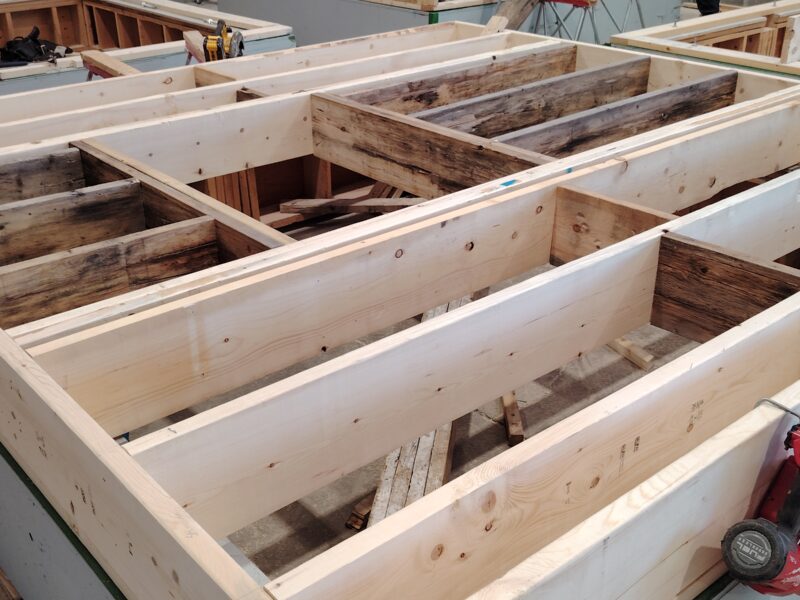It’s a practical guide for ensuring the structural integrity and longevity of wood post installations in framed structures
Several critical facts to be considered:
* Proper Connections: Demonstrates various methods for securely fastening posts, which are crucial for stability and safety.
* Load Transfer: Shows how brackets, bolts, and blocking work together to transfer loads from the post to the framing.
* Reinforcement: Highlights the use of blocking and long bolts to reinforce connections, especially in critical areas like corners or when posts are not directly aligned with joists.
* Hardware Specification: Provides specific hardware sizes (1/2″ bolts, 10d nails) for professional-level execution.
Common Elements:
* WOOD POST: The vertical timber member being installed.
* RIM JOIST: The outermost horizontal framing member of a deck or floor, running perpendicular to the main joists.
* END JOIST: A horizontal framing member that caps the end of the joists, running parallel to the rim joist in some configurations.
* BRACKET: A metal connector specifically designed to attach the post to the framing.
* 1/2″ BOLT, NUT & WASHER: Hardware used to secure the post and/or bracket to the framing.
* ≥16″ BLOCKING ATTACHED WITH 24-10d NAILS: Refers to short pieces of wood (blocking) installed between joists, at least 16 inches long, secured with a specific number and size of nails (24-10d nails, meaning 24 nails of 10-penny size). This blocking provides a solid attachment point.
1. Post along rim joist
* Description: The wood post is positioned directly against the inner face of the rim joist.
* Attachment: A bracket is used to connect the post to the rim joist. The rim joist itself is reinforced by a piece of blocking installed perpendicular to it and between adjacent joists, connected with nails. A 1/2″ bolt passes through the post, bracket, and rim joist.
* Purpose: A common and straightforward way to attach a post along the side of a deck, often for railing support or a corner.
2. Post unaligned to joist
* Description: The wood post is installed at a location where there isn’t a direct joist for support.
* Attachment: A bracket connects the post to the rim joist. Crucially, a piece of “≥16″ BLOCKING” is installed between two adjacent joists, perpendicular to the rim joist. This blocking provides the necessary structural support for the bracket and bolt, ensuring the post is firmly anchored.
* Purpose: Allows for flexible post placement where direct joist alignment isn’t feasible or desired.
3. Double post at outside corner
* Description: Two wood posts are installed at an outside corner of the deck frame.
* Attachment: A bracket connects both posts to the rim joist and the end joist. A 1/2″ bolt passes through the posts and both joists.
* Purpose: Provides robust support at a corner, often for structural elements like a roof post or a significant railing.
4. Post along end joist
* Description: The wood post is positioned directly along the inner face of an end joist (which runs parallel to the main joists).
* Attachment: A bracket connects the post to the end joist. A “LONG BOLT OR THREADED ROD” is shown passing through the post, bracket, and the end joist, potentially extending through blocking if present, or into a “FIRST INBOARD JOIST” for more substantial connection.
* Purpose: Used when a post needs to be anchored along a section where the joists run parallel to the post’s alignment.
5. Post at outside corner
* Description: A single wood post is installed at an outside corner of the deck frame.
* Attachment: A bracket connects the post directly to the rim joist and end joist. A 1/2″ bolt passes through the post and both joists. Similar to “Double post at outside corner” but for a single post.
* Purpose: Standard method for a single corner post, providing support for railings or minor loads.
6. Post at inside corner
* Description: A wood post is installed at an inside corner of the deck frame, where two rim joists (or a rim joist and an end joist) meet in an interior angle.
* Attachment: A bracket connects the post to both the rim joist and the end joist. “INBOARD JOISTS” are shown, with a “LONG BOLT OR THREADED ROD” passing through the post, the corner joists, and into the inboard joist for maximum stability. This setup suggests a more robust connection for heavier loads or more critical structural points.
* Purpose: Provides strong support at an inside corner, often for critical structural elements or where concentrated loads are expected.


